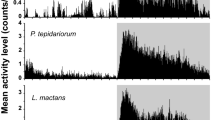Summary
The locomotor activity of 35 individuals of a blind and depigmented cave Millipede,Blaniulus lichtensteini Bröl., was recorded (58 one month-records) in free running conditions (DD, 14.5 °C, R. H. 100%).
No rhythm was plainly evident directly on the histograms. Treating the raw data by Enright's periodogram or by Autocorrelation lets appear brief rhythmic sequences (some days, one week) with a period lying often around 12 or 24 hours.
By mean of an autocorrelation program running over a narrow window which sweeps stepwise the whole record, it has been found in 32 cases over 58 a special type of rhythm with gliding frequency.
This temporal structure seems very alike that exhibited by the cave CrayfishOrconectes pellucidus (Jegla and Poulson, 1968) and shows that cave animals, despite the lack of any selection pressure, do not lose completely their “internal clock”.
Resume
L'activité locomotrice de 35 individus d'un Diplopode troglobieBlaniulus lichtensteini Bröl. a été enregistrée (58 enregistrements d'un mois) en libre-cours (obscurité, 14°5, H. R. 100%).
Aucun rythme n'est directement évident sur les histogrammes. Le traitement des données par le périodogramme d'Enright ou par l'autocorrélation montre des rythmes temporaires (quelques jours, une semaine) de période souvent proche de 12 ou de 24 heures.
Par un calcul d'autocorrélation portant sur une fenêtre étroite qui balaie pas à pas tout l'enregistrement, on trouve dans 32 cas sur 58 un type bien particulier de rythme, à fréquence glissante.
L'organisation temporelle ainsi mise en évidence rappelle ce qui a été trouvé chez une Ecrevisse troglobieOrconectes pellucidus (Jegla and Poulson, 1968) et montre que, malgré l'absence de toute pression de sélection, les animaux cavernicoles ne perdent pas complètement leur ≪horloge interne≫.
Similar content being viewed by others
Bibliographie
Enright, J. T.: Accurate geophysical rhythms and frequency analysis. In:Circadian clocks (J. Aschoff, ed.), p. 31–42. Amsterdam: North Holland Public. Comp., 1965
Gilhodes, J. C., Monnier, S., Rage, P.: Actographie par marquage aux radioisotopes. Rev. Comp. Animal4, 79–81 (1970).
Husson, R.: Rythmes biologiques et vie cavernicole. Bull. Soc. Zool. France96, 301–316 (1971)
Jegla, T. C., Poulson, T. L.: Evidence of circadian rhythms in a cave crayfish. J. exp. Zool.168, 273–282 (1968)
Rage, P., Monnier, S., Gilhodes, J. C.: Une nouvelle utilisation des radio-isotopes en biologie dans l'étude de l'activité locomotrice. Rayonnements ionisants No 2, 56–65 (1971)
Author information
Authors and Affiliations
Rights and permissions
About this article
Cite this article
Mead, M., Gilhodes, JC. Organisation temporelle de l'activité locomotrice chez un animal cavernicoleBlaniulus lichtensteini Bröl. (Diplopoda). J. Comp. Physiol. 90, 47–52 (1974). https://doi.org/10.1007/BF00698366
Received:
Issue Date:
DOI: https://doi.org/10.1007/BF00698366




